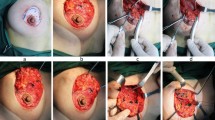Abstract
Various traditional gland dermal pedicle techniques for breast ptosis had disadvantages, such as inverted T or vertical scars and poor sensation function in the nipple and areola in most cases, or even an unesthetic shape in some cases. We felt that these disadvantages could be minimized by using a novel double-ring method with local tissue rearrangement, aiming to correct mastoptosis and preserve the firmness of the breast structure. We used a novel double-ring method with local tissue rearrangement in 35 patients with varying degrees of breast ptosis. Ten patients needed breast volume reduction simultaneously with correction of breast ptosis. Satisfaction with the results among all patients was assessed by a questionnaire. The clinical data, surgical outcome, and follow-up evaluation of the patients were analyzed from follow data and well maintained hospital records. All patients were followed up for at least 1 year. Most of the patients were very satisfied with the firmness of the breast structure, invisible scars, and good viability and sensation of the nipple-areola complex (NAC). The results were durable and stable, and the incidence of complications was low. Concealed areola scarring was the most important advantage of this technique over other techniques for Asians. This novel technique might be a valid option for traditional methods, especially for Asian breasts due to invisible scars. This method could also achieve a good result in patients who did not have adequate breast volume and did not accept prosthesis implantation.








Similar content being viewed by others
Data Availability
The data are available from the corresponding author on reasonable request.
References
Groyecka A, Żelaźniewicz A, Misiak M, Karwowski M, Sorokowski P (2017) Breast shape (ptosis) as a marker of a woman’s breast attractiveness and age: evidence from Poland and Papua. Am J Hum Biol 29:e22981
Tebbetts JB (2014) A process for quantifying aesthetic and functional breast surgery: II. Applying quantified dimensions of the skin envelope to design and preoperative planning for mastopexy and breast reduction. Plast Reconstr Surg 133(3):527–542
Achebe JU, Njeze GE, Okwesili OR (2014) Treatment of unilateral giant fibroadenoma by breast reduction skin incision: the inverted “T” technique. Niger J Clin Pract 17(1):43–6
Rinker B, Veneracion M, Walsh CP (2010) Breast ptosis: causes and cure. Ann Plast Surg 64(5):579–584
Neri JB (1983) Mastopexy and breast reduction in Asians. Ann Acad Med Singap 12(2 Suppl):456–459
Corduff N, Taylor GI (2004) Subglandular breast reduction: the evolution of a minimal scar approach to breast reduction. Plast Reconstr Surg 113(1):175–184
Ding W, Ding Y, Jiang H (2017) Reduction mammaplasty with the modified round block technique in Chinese patients and its anatomy study. J Plast Surg Hand Surg 51(5):306–312
MA Le, Song LP, Hong SZ, Jie HT, Xiao C (2012) The application of folding technique in round block reduction mammaplasty. Chinese J Aesthet Med 13(10):24–25
Lalardrie JP, Jouglard JP (1982) Reduction mammoplasty: general approach and basic considerations. Aesthet Plast Surg 6(2):81–83
Grant JH 3rd, Rand RP (2001) The maximally vascularized central pedicle breast reduction: evolution of a technique. Ann Plast Surg 46(6):584–589
Hofmann AK, Wuestner-Hofmann MC, Bassetto F, Scarpa C, Mazzoleni F (2007) Breast reduction: modified “Lejour technique” in 500 large breasts. Plast Reconstr Surg 120(5):1095–1104
Cheng MH, Huang JJ (2009) Augmentation mammaplasty in Asian women. Semin Plast Surg 23(1):48–54
Rohrich RJ, Thornton JF, Jakubietz RG, Jakubietz MG, Grünert JG (2004) The limited scar mastopexy: current concepts and approaches to correct breast ptosis. Plast Reconstr Surg 114(6):1622–1630
Nicoletti G, Scevola S, Faga A (2009) Breast sculpturing: overcoming the limits of traditional approaches in breast reduction. Aesthetic Plast Surg 33(2):204–212
Wollina U, Goldman A (2011) Minimally invasive esthetic procedures of the male breast. J Cosmet Dermatol 10(2):150–155
Shin KS, Chung S, Lee HK, Lew JD (1996) Reduction mammaplasty by central pedicle flap with short submammary scar. Aesthetic Plast Surg 20(1):69–76
Shan XY, Huang XM, Wang MS, Zheng HB, Liu ZL, Wang B (2016) Follow-up observational study of “bi-ring method” breast surgery for treating hypermastia and mastoptosis. Clin Exp Obstet Gynecol 43(1):57–62
Funding
This study was supported by the Natural Science Foundation of Guangdong Province (2018A030313900) and the 5010 Research Project of Sun Yat-sen University (2019017).
Author information
Authors and Affiliations
Contributions
JMZ performed the operation. JMZ and WQL designed the research. JMZ and WQL performed data search and screening. JZ and JQZ analyzed the data, and JZ and XLX wrote the manuscript. JMZ reviewed the manuscript. CC and YZW provided analysis instructions. ZS revised the manuscript.
Corresponding authors
Ethics declarations
Ethics Approval and Consent to Participate
The study followed the guidance of the Ethics Committee of Sun Yat-sen Memorial Hospital, Sun Yat-sen University and Declaration of Helsinki, and all participants provided informed written consent. The study adhered to the STROBE reporting guidelines.
Conflict of Interest
The authors declare no competing interests.
The EC number: EC-20220525–1005.
Additional information
Publisher's Note
Springer Nature remains neutral with regard to jurisdictional claims in published maps and institutional affiliations.
Supplementary Information
Below is the link to the electronic supplementary material.
Rights and permissions
Springer Nature or its licensor (e.g. a society or other partner) holds exclusive rights to this article under a publishing agreement with the author(s) or other rightsholder(s); author self-archiving of the accepted manuscript version of this article is solely governed by the terms of such publishing agreement and applicable law.
About this article
Cite this article
Zhang, J., Xiao, X., Zhang, J. et al. “Double-Ring” Method for Treating Breast Ptosis: a New Approach with Local Tissue Rearrangement. Indian J Surg 85, 1450–1457 (2023). https://doi.org/10.1007/s12262-023-03738-8
Received:
Accepted:
Published:
Issue Date:
DOI: https://doi.org/10.1007/s12262-023-03738-8




